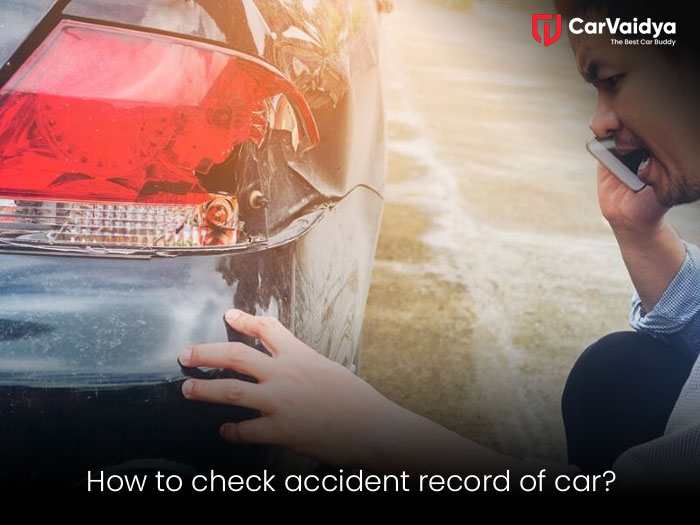Checking if a car has been in an accident is a necessary step in the system of buying a used vehicle. Knowing the car's history can save you from probable future problems and financial losses. Here is an exhaustive guide on how to check if a car has been in an accident.
1. Obtain the Vehicle Identification Number (VIN)
The first step in checking a car's accident history is to access, its Vehicle Identification Number (VIN). The VIN is a unique 17-character code that identifies a definitive vehicle. You can normally find the VIN on the dashboard, driver's side door, vehicle registration documents, or insurance papers.

2. Use Online Vehicle History Report Services
Several online services provide detailed vehicle history reports using the VIN. These reports can reveal if the car has been in an accident, among other important information.
- Carfax: One of the most well-known services, Carfax provides comprehensive reports that include accident history, title information, service records, and more.
- AutoCheck: Similar to Carfax, AutoCheck offers detailed vehicle history reports and scores vehicles based on their history.
- National Motor Vehicle Title Information System (NMVTIS): This government-backed database provides information about a car's title, odometer reading, and history of damage.
These services typically charge a fee, but the information they provide is invaluable when assessing a used car's condition.
3. Examine the Car’s Exterior
A physical inspection of the car's exterior can reveal signs of previous accidents. Here’s what to look for:
- Paint Consistency: Look for inconsistencies in the paint color and texture. A difference in paint on various parts of the car might indicate that it has been repainted after an accident.
- Body Panel Gaps: Check the gaps between body panels. Uneven or wide gaps can be a sign that parts have been replaced or realigned following a collision.
- Rust and Corrosion: Excessive rust or corrosion, particularly in areas that are not typically exposed to elements, can suggest previous damage.
- Scratches and Dents: Look for scratches, dents, or other surface imperfections that might indicate a collision.
4. Inspect the Car’s Interior
The interior of the car can also provide clues about its accident history:
- Airbag Indicators: Ensure that all airbag indicators are functioning correctly. A non-functional airbag light or visible airbag marks on the dashboard can indicate a previous deployment.
- Seatbelt Condition: Check the seatbelts for fraying or excessive wear, which might be due to sudden tension during an accident.
- Dashboard and Trim: Look for signs of repairs or replacements in the dashboard or trim. Mismatched components can indicate previous damage.
5. Check Under the Hood
Inspecting under the hood can reveal hidden damage:
- Radiator Support: Check the radiator support for bends, dents, or signs of welding, which might indicate a front-end collision.
- Frame Damage: Look for any signs of frame damage or repair, such as welds, bends, or new bolts.
- Fluid Leaks: Inspect for any fluid leaks that could be a result of collision damage.
6. Review the Car’s Undercarriage
The undercarriage can show signs of severe damage that might not be visible from above:
- Suspension Components: Check for new or mismatched suspension components, which can indicate replacement following an accident.
- Frame Damage: Look for bends, cracks, or signs of repair in the frame.
- Rust and Corrosion: Excessive rust on the undercarriage can indicate long-term exposure to the elements, possibly due to accident damage.
7. Take the Car for a Test Drive
A test drive can reveal mechanical issues resulting from past accidents:
- Steering and Alignment: Pay attention to how the car steers and whether it pulls to one side, which might indicate alignment issues due to a collision.
- Suspension: Listen for unusual noises from the suspension system, which can be a sign of previous damage.
- Brakes: Test the brakes for responsiveness and unusual noises, as braking components can be damaged in accidents.
8. Consult a Professional Mechanic
Having a trusted mechanic inspect the car is one of the most effective ways to identify past accident damage. Mechanics can provide a thorough inspection and often spot issues that may not be apparent to the untrained eye.
9. Request Maintenance Records
Maintenance records can provide insight into the car’s history and any significant repairs:
- Consistent Maintenance: Look for consistent maintenance records. Gaps in the maintenance history can sometimes indicate periods when the car was being repaired after an accident.
- Major Repairs: Check for records of major repairs, particularly those involving bodywork or structural components.
10. Check with Insurance Companies
Insurance companies maintain records of claims made for accidents. If possible, contact previous insurers to check if any claims were made for accident repairs.
11. Use Social Media and Online Forums
In some cases, social media and online forums can give information about a car's history. Previous owners or car aficionados might share information about the car, including any accidents.
12. Verify Title Information
Check the car’s title for any indications of salvage or repaired status. A salvage title means the car was announced a total loss by an insurance company, normally due to severe damage from an accident. A rebuilt title indicates the car was repaired and inspected to ensure it meets safety standards.
Checking if a car has been in an accident involves a solution of online research, physical inspection, and experienced assessment. By following these steps, you can make an informed decision and avoid potential issues down the road. Always prioritize safety and transparency when purchasing a used car to ensure you are investing in a reliable vehicle.
You can read some other articles
5 steps to negotiate car repair prices
The comprehensive guide to tire pressure
Keeping your windscreen safe

